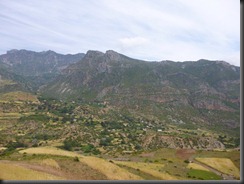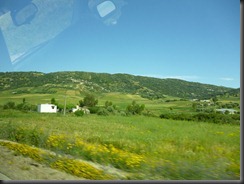June 1 (Saturday)
Washington DC
Catching us up on the narrative, from DC. After three nights in Chefchaouen and the Caiat Refuge, we packed up and headed out, at least initially planning to go to Fez. I think our general interest in another big city with riads and medinas and kasbahs and traffic was kind of limited, so we decided instead to take advantage of having a car, thanks to Becca and Tono, (who we really owe for dealing with truly insane traffic) and head north, to Tangier and Assilah. Those two coastal cities would be easy to reach by train from Rabat, but from Chefchaouen they were basically inaccessible (no train runs out of Chefchaouen).
We drove on some beautiful and winding roads through the Rif Mountains to get there:
Tangier has always been a crucial juncture in the Mediterranean, as it controlled access to the Strait of Gibraltar and by extension the Mediterranean Sea and Atlantic Ocean. But Tangier is probably best known for its time as an International Zone after World War II, where it was a gathering point for artists, spies and hippies from all over Europe and the United States.The rest of Morocco was divided between French and Spanish colonial possessions, but Tangier remained a kind of North African Berlin: split between the French, Spanish, Italians, Americans and Swedes, among others, it became a stewing pot of ideas and people from around the world. It attracted artists, thinkers and writers from the beat culture, including Allen Ginsburg, Paul Bowles and William Burroughs.
The first place we checked out, Cinema Rif, was on the Grand Socco, a large palm-lined plaza at the entrance to the medina. Theaters and movies in general don’t attract much of a crowd at all in Moroccan culture (there is one theater in Casablanca evidently that plays some movies with varying frequency), but Cinema Rif stands as a relic almost of another age. Walking in you feel you would bump into Humphrey Bogart smoking a cigarette at the bar. Here are some photos to give you a feel:
After the Cinema Rif, we set out to find a place to eat lunch and had in our sights “Le Populaire Saveur de Poisson,” a real authentic hole in the wall that was crowded at lunch time with both tourists and locals. The amount of Crazy Crap on the Walls gave it a vaguely Moroccan Seafood Cracker Barrel flair, but the food was quite delicious. We sat down and were given big sheets of rough paper and glasses with napkins (no plates or silverware). We were immediately supplied with a juice cocktail of about fifteen berries by the “owner'” (manager?) who came by and gave us various honorifics: Tono was Presidente, Dave was Bice Presidente, I was El Profesor (wearing glasses), etc. We did not really order (I can’t remember) because the food simply started coming. The set menu was what everyone gets, and so the parade of plates began. We had a simple but hearty seafood soup at the beginning with fresh bread and olives and a spicy oil. Followed by an enormous plate of stewed seafood in lemon and spinach. Having mopped it all up with the bread and feeling pretty proud of ourselves we were more than a little shocked when two enormous full fish were plopped down in front of us. There. Was. No. Way. And we said that. Owner/Manager was quite concerned. This is fine food, fine fish – you want me to send this back? With deep sadness he took the plates back. But we still managed to handle dessert, wink.
We wandered through the old medina part of town and passed the American Legation Museum, which has a number of firsts associated with it. Morocco was the first nation to recognize the new United States in the late 1770s as a new nation. So the first American real estate abroad was here in Morocco, in this five story mansion in Tangier. There was actually a letter in the museum from George Washington to Sultan Moulay Suleyman thanking him for recognizing our new nation. Additionally, this historic landmark is the only U.S. National Historic Landmark on foreign soil. Neat!
There was also a subtle American influence here in this part of town: A “Bab Merican” (adorable combination of the Arabic word for Gate and the Moroccan bastardization of “American”), and Rue D’Amerique. Etc.
We got afternoon tea at Salon Bleu which was a nice spot to relax on their upper patio looking down over the city. We also walked by the northern edge of the city where on a clear day you can see Spain and the Rock of Gibraltar across the Straight. We couldn’t actually see Spain given the clouds and distant haziness, but here is where is should have been:
Having “seen Spain,” eaten an enormous seafood lunch and had afternoon tea, we were content to head out, further south to Assilah, a picturesque whitewashed artists enclave about a half hour south of Tangier. Assilah was really gorgeous, and had been systematically cleaned up by its forward-thinking mayor who wants it “as clean as Switzerland.” There are a lot of artists’ workshops and we were almost immediately confronted by an artist who wanted us to buy his drawings on the backs of cement bags. Despite being impressed by his resourcefulness and environmental consciousness, we declined to make a purchase and he promptly told us we were “killing his culture” and stormed off in a disappointed huff.
The town was really cool. Almost entirely white in certain parts (see below), in other parts the artists had used the whitewashed walls as enormous free public canvasses and put out their own work. We enjoyed walking through the chill, quiet little streets of the medina and up to the 15th century Portuguese ramparts that surround the medina and dramatically abut the Atlantic Ocean, guns still ominously keeping watch over the water. I still kind of get goosebumps thinking about us walking across those old batteries against the Atlantic.
Select images from my unbound photo-spree:
Two of the many murals in Assilah:
After Assilah we had pretty much had had a full day (visited three towns in 12 hours technically) and we drove south down the coast to Rabat, catching occasional glimpses of the sun setting over the Atlantic as we went.

















































